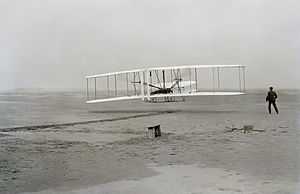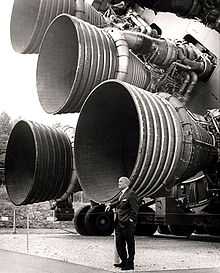Aerospace engineering
|
NASA engineers, seen here in mission control during Apollo 13, worked diligently to protect the lives of the astronauts on the mission. | |
| Occupation | |
|---|---|
| Names |
engineer aerospace engineer |
Occupation type | profession |
Activity sectors | aeronautics, astronautics, science |
| Description | |
| Competencies | technical knowledge, management skills |
Education required | see professional requirements |
Aerospace engineering is the primary branch of engineering concerned with the research, design process, development, construction, testing, science and technology of aircraft and spacecraft.[1] It is divided into two major and overlapping branches: aeronautical engineering and astronautical engineering. Aeronautics deals with aircraft that operate in Earth's atmosphere, and astronautics deals with spacecraft that operate outside the Earth's atmosphere. Founded by pioneers such as Konstantin Tsiolkovsky,[2] the field reached its maturity with launching of first artificial satellite, first man in space and first step on the Moon.
Aerospace Engineering deals with the design, construction, and study of the science behind the forces and physical properties of aircraft, rockets, flying craft, and spacecraft. The field also covers their aerodynamic characteristics and behaviors, airfoil, control surfaces, lift, drag, and other properties.
Aeronautical engineering was the original term for the field. As flight technology advanced to include craft operating in outer space, the broader term "aerospace engineering" has largely replaced it in common usage.[3] Aerospace engineering, particularly the astronautics branch, is often referred to colloquially as "rocket science",[4] such as in popular culture.
Overview
Flight vehicles are subjected to demanding conditions such as those produced by changes in atmospheric pressure and temperature, with structural loads applied upon vehicle components. Consequently, they are usually the products of various technological and engineering disciplines including aerodynamics, propulsion, avionics, materials science, structural analysis and manufacturing. The interaction between these technologies is known as aerospace engineering. Because of the complexity and number of disciplines involved, aerospace engineering is carried out by teams of engineers, each having their own specialised area of expertise.[5]
The development and manufacturing of a modern flight vehicle is an extremely complex process and demands careful balance and compromise between abilities, design, available technology and costs. Aerospace engineers design, test, and supervise the manufacture of aircraft, spacecraft, and missiles. Aerospace engineers develop new technologies for use in aviation, defense systems, and space.
History

The origin of aerospace engineering can be traced back to the aviation pioneers around the late 19th to early 20th centuries, although the work of Sir George Cayley dates from the last decade of the 18th to mid-19th century. One of the most important people in the history of aeronautics,[6] Cayley was a pioneer in aeronautical engineering[7] and is credited as the first person to separate the forces of lift and drag, which are in effect on any flight vehicle.[8] Early knowledge of aeronautical engineering was largely empirical with some concepts and skills imported from other branches of engineering.[9] Scientists understood some key elements of aerospace engineering, like fluid dynamics, in the 18th century. Many years later after the successful flights by the Wright brothers, the 1910s saw the development of aeronautical engineering through the design of World War I military aircraft.
The first definition of aerospace engineering appeared in February 1958.[3] The definition considered the Earth's atmosphere and the outer space as a single realm, thereby encompassing both aircraft (aero) and spacecraft (space) under a newly coined word aerospace. In response to the USSR launching the first satellite, Sputnik into space on October 4, 1957, U.S. aerospace engineers launched the first American satellite on January 31, 1958. The National Aeronautics and Space Administration was founded in 1958 as a response to the Cold War.[10]
Elements

Some of the elements of aerospace engineering are:[11][12]

- Fluid mechanics – the study of fluid flow around objects. Specifically aerodynamics concerning the flow of air over bodies such as wings or through objects such as wind tunnels (see also lift and aeronautics).
- Astrodynamics – the study of orbital mechanics including prediction of orbital elements when given a select few variables. While few schools in the United States teach this at the undergraduate level, several have graduate programs covering this topic (usually in conjunction with the Physics department of said college or university).
- Statics and Dynamics (engineering mechanics) – the study of movement, forces, moments in mechanical systems.
- Mathematics – in particular, calculus, differential equations, and linear algebra.
- Electrotechnology – the study of electronics within engineering.
- Propulsion – the energy to move a vehicle through the air (or in outer space) is provided by internal combustion engines, jet engines and turbomachinery, or rockets (see also propeller and spacecraft propulsion). A more recent addition to this module is electric propulsion and ion propulsion.
- Control engineering – the study of mathematical modeling of the dynamic behavior of systems and designing them, usually using feedback signals, so that their dynamic behavior is desirable (stable, without large excursions, with minimum error). This applies to the dynamic behavior of aircraft, spacecraft, propulsion systems, and subsystems that exist on aerospace vehicles.
- Aircraft structures – design of the physical configuration of the craft to withstand the forces encountered during flight. Aerospace engineering aims to keep structures lightweight.
- Materials science – related to structures, aerospace engineering also studies the materials of which the aerospace structures are to be built. New materials with very specific properties are invented, or existing ones are modified to improve their performance.
- Solid mechanics – Closely related to material science is solid mechanics which deals with stress and strain analysis of the components of the vehicle. Nowadays there are several Finite Element programs such as MSC Patran/Nastran which aid engineers in the analytical process.
- Aeroelasticity – the interaction of aerodynamic forces and structural flexibility, potentially causing flutter, divergence, etc.
- Avionics – the design and programming of computer systems on board an aircraft or spacecraft and the simulation of systems.
- Software – the specification, design, development, test, and implementation of computer software for aerospace applications, including flight software, ground control software, test & evaluation software, etc.
- Risk and reliability – the study of risk and reliability assessment techniques and the mathematics involved in the quantitative methods.
- Noise control – the study of the mechanics of sound transfer.
- Aeroacoustics – the study of noise generation via either turbulent fluid motion or aerodynamic forces interacting with surfaces.
- Flight test – designing and executing flight test programs in order to gather and analyze performance and handling qualities data in order to determine if an aircraft meets its design and performance goals and certification requirements.
The basis of most of these elements lies in theoretical physics, such as fluid dynamics for aerodynamics or the equations of motion for flight dynamics. There is also a large empirical component. Historically, this empirical component was derived from testing of scale models and prototypes, either in wind tunnels or in the free atmosphere. More recently, advances in computing have enabled the use of computational fluid dynamics to simulate the behavior of fluid, reducing time and expense spent on wind-tunnel testing. Those studying hydrodynamics or Hydroacoustics often obtained degrees in Aerospace Engineering.
Additionally, aerospace engineering addresses the integration of all components that constitute an aerospace vehicle (subsystems including power, aerospace bearings, communications, thermal control, life support, etc.) and its life cycle (design, temperature, pressure, radiation, velocity, lifetime).
Degree programs
Aerospace engineering may be studied at the advanced diploma, bachelor's, master's, and Ph.D. levels in aerospace engineering departments at many universities, and in mechanical engineering departments at others. A few departments offer degrees in space-focused astronautical engineering. Some institutions differentiate between aeronautical and astronautical engineering.
In popular culture
The term "rocket scientist" is sometimes used to describe a person of great intelligence since "rocket science" is seen as a practice requiring great mental ability, especially technical and mathematical ability.
The term is used ironically in the expression "It's not rocket science" to indicate that a task is simple.[13]
Strictly speaking, the use of the word "science" in "rocket science" is a misnomer since science is about understanding the origins, nature, and behavior of the universe; engineering is about using scientific and engineering principles to solve problems and develop new technology. However, the media and the public often use "science" and "engineering" as synonyms.[14]
See also
| At Wikiversity, you can learn more and teach others about Aerospace engineering at the Department of Aerospace engineering |
- American Institute of Aeronautics and Astronautics
- Flight test
- List of aerospace engineering topics
- List of aerospace engineers
- List of Russian aerospace engineers
- List of aerospace engineering schools
- Sigma Gamma Tau (aerospace engineering honor society)
References
- ↑ Encyclopedia of Aerospace Engineering. Wiley & Sons. October 2010. ISBN 978-0-470-75440-5.
- ↑ Konstantin E. Tsiolkovsky – Soviet Space Scientist. From San Diego Aerospace Museum Educational Materials
- ↑ 3.0 3.1 Stanzione, Kaydon Al (1989). "Engineering". Encyclopædia Britannica 18 (15 ed.). Chicago. pp. 563–563.
- ↑ Longuski, Jim (2004). Advice to Rocket Scientists: A Career Survival Guide for Scientists and Engineers. Reston, Virginia: American Institute of Aeronautics and Astronautics (AIAA). p. 2. ISBN 1-56347-655-X.
If you have a degree in aerospace engineering or in astronautics, you are a rocket scientist.
- ↑ "Career: Aerospace Engineer". Career Profiles. The Princeton Review. Retrieved 2006-10-08.
Due to the complexity of the final product, an intricate and rigid organizational structure for production has to be maintained, severely curtailing any single engineer's ability to understand his role as it relates to the final project.
- ↑ "Sir George Cayley". ?. Retrieved 2009-07-26.
Sir George Cayley is one of the most important people in the history of aeronautics. Many consider him the first true scientific aerial investigator and the first person to understand the underlying principles and forces of flight.
- ↑ "Sir George Cayley (British Inventor and Scientist)". Britannica. n.d. Retrieved 2009-07-26.
English pioneer of aerial navigation and aeronautical engineering and designer of the first successful glider to carry a human being aloft.
- ↑ "The Pioneers: Aviation and Airmodelling". ?. Retrieved 2009-07-26.
Sir George Cayley is sometimes called the 'Father of Aviation'. A pioneer in the field, he is credited with the first major breakthrough in heavier-than-air flight. He was the first to identify the four aerodynamic forces of flight – weight, lift, drag, and thrust – and their relationship and also the first to build a successful human carrying glider.
- ↑ Kermit Van Every (1988). "Aeronautical engineering". Encyclopedia Americana 1. Grolier Incorporated.
- ↑ "A Brief History of NASA". Hq.nasa.gov. Retrieved 2012-03-20.
- ↑ "Science: Engineering: Aerospace". Open Site. Retrieved 2006-10-08.
- ↑ Gruntman, Mike (September 19, 2007). "The Time for Academic Departments in Astronautical Engineering". AIAA SPACE 2007 Conference & Exposition Agenda. AIAA SPACE 2007 Conference & Exposition. AIAA.
- ↑ Bailey, Charlotte (7 November 2008). "Oxford compiles list of top ten irritating phrases". The Daily Telegraph. Retrieved 2008-11-18.
10 - It's not rocket science
- ↑ . IEEE Spectrum, December 2010.
External links
- NDTAeroTech.com, The Online Community for Aerospace NDT Professionals
- Kroo, Ilan. "Aircraft Design: Synthesis and Analysis". Stanford University. Retrieved 17 January 2015.
| ||||||||||||||||||||||||||||||
| ||||||||||||||||||||||||||||||
